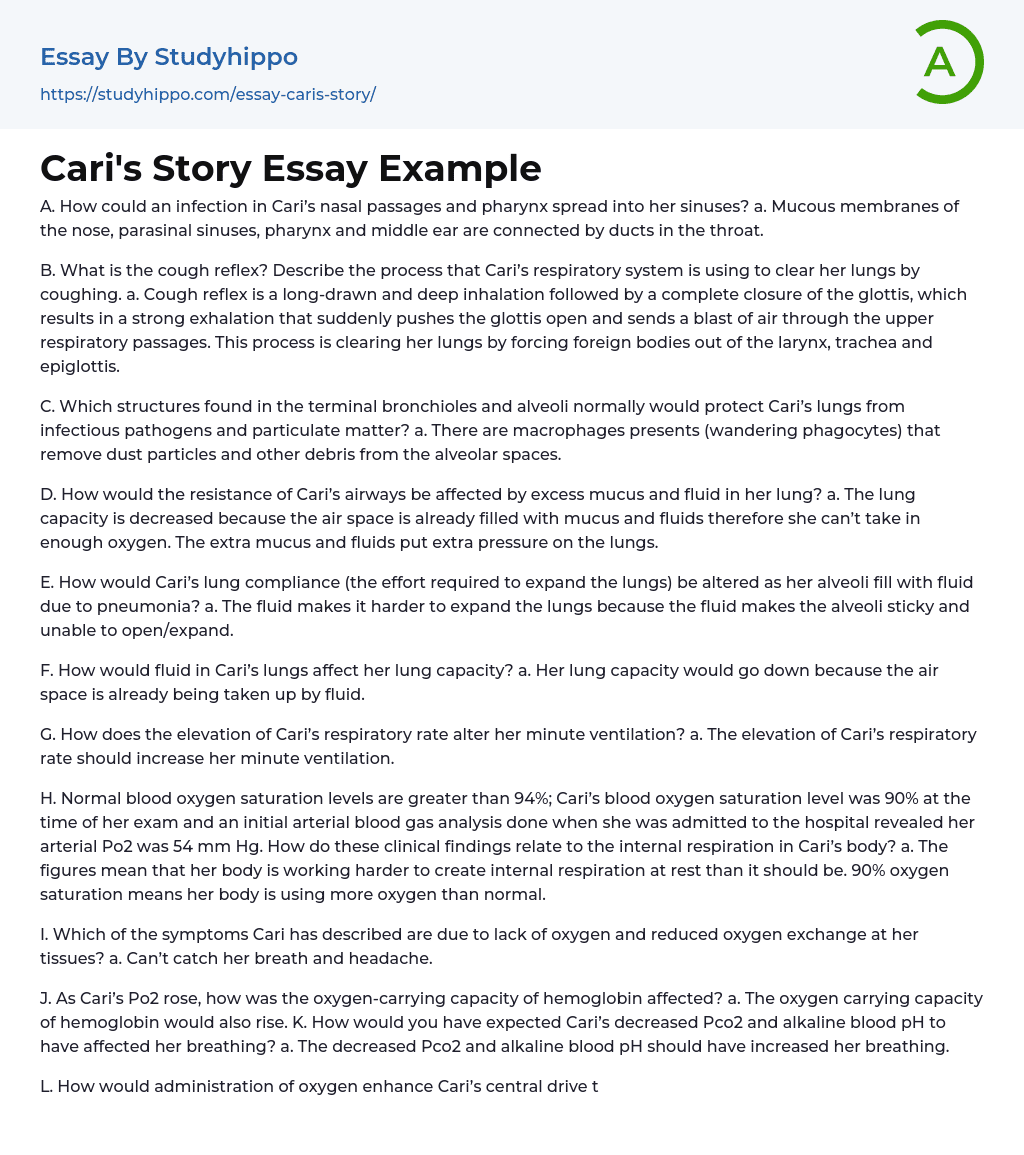A. How could an infection in Cari’s nasal passages and pharynx spread into her sinuses? a. Mucous membranes of the nose, parasinal sinuses, pharynx and middle ear are connected by ducts in the throat.
B. What is the cough reflex? Describe the process that Cari’s respiratory system is using to clear her lungs by coughing. a. Cough reflex is a long-drawn and deep inhalation followed by a complete closure of the glottis, which results in a strong exhalation that suddenly pushes the glottis open and sends a blast of air through the upper respiratory passages. This process is clearing her lungs by forcing foreign bodies out of the larynx, trachea and epiglottis.
C. Which structures found in the terminal bronchioles and alveoli normally would protect Cari’s lungs from infectious pathogens and partic
...ulate matter? a. There are macrophages presents (wandering phagocytes) that remove dust particles and other debris from the alveolar spaces.
D. How would the resistance of Cari’s airways be affected by excess mucus and fluid in her lung? a. The lung capacity is decreased because the air space is already filled with mucus and fluids therefore she can’t take in enough oxygen. The extra mucus and fluids put extra pressure on the lungs.
E. How would Cari’s lung compliance (the effort required to expand the lungs) be altered as her alveoli fill with fluid due to pneumonia? a. The fluid makes it harder to expand the lungs because the fluid makes the alveoli sticky and unable to open/expand.
F. How would fluid in Cari’s lungs affect her lung capacity? a. Her lung capacity would go down because
the air space is already being taken up by fluid.
G. How does the elevation of Cari’s respiratory rate alter her minute ventilation? a. The elevation of Cari’s respiratory rate should increase her minute ventilation.
H. Normal blood oxygen saturation levels are greater than 94%; Cari’s blood oxygen saturation level was 90% at the time of her exam and an initial arterial blood gas analysis done when she was admitted to the hospital revealed her arterial Po2 was 54 mm Hg. How do these clinical findings relate to the internal respiration in Cari’s body? a. The figures mean that her body is working harder to create internal respiration at rest than it should be. 90% oxygen saturation means her body is using more oxygen than normal.
I. Which of the symptoms Cari has described are due to lack of oxygen and reduced oxygen exchange at her tissues? a. Can’t catch her breath and headache.
J. As Cari’s Po2 rose, how was the oxygen-carrying capacity of hemoglobin affected? a. The oxygen carrying capacity of hemoglobin would also rise. K. How would you have expected Cari’s decreased Pco2 and alkaline blood pH to have affected her breathing? a. The decreased Pco2 and alkaline blood pH should have increased her breathing.
L. How would administration of oxygen enhance Cari’s central drive to breathe? a. The increased oxygen would drive the body to want to exhale and then inhale because the gas levels would change from high to low. A high level of oxygen would drive exhalation and a low level of oxygen would drive inhalation.
M. Which anatomical structures in Cari’s respiratory
system were initially involved? a. Nose, throat, sinuses, lungs, bronchioles, and alveoli were initially involved.
N. Why was Cari plagued with a chronic smoker’s cough?
a. Cari’s was plagued with a chronic smoker’s cough to help expel foreign objects from her upper respiratory tract. Smoking paralyzed the cilia and stimulated the goblet cells lining her respiratory passes to secrete extra mucus which resulted in the macrophages and neutrophils trying to fight off the smoke to get stuck in the mucus, resulting in pneumonia.
O. Which damaging effects of tobacco smoke led to Cari’s impaired respiratory defense mechanisms? a. Smoking paralyzed the cilia and stimulated the goblet cells lining her respiratory passes to secrete extra mucus which resulted in the macrophages and neutrophils trying to fight off the smoke to get stuck in the mucus, resulting in pneumonia.
P. How did the pneumonia affect Cari’s lung function?
a. Pneumonia decreased Cari’s lung function because the air space that would normally have been used for gas exchange was being taken up by mucus, pus and fluids. The mucus, pus and fluids made it harder for the body to expand the alveoli to produce gas exchange.
- John Locke essays
- 9/11 essays
- A Good Teacher essays
- A Healthy Diet essays
- A Modest Proposal essays
- A&P essays
- Academic Achievement essays
- Achievement essays
- Achieving goals essays
- Admission essays
- Advantages And Disadvantages Of Internet essays
- Alcoholic drinks essays
- Ammonia essays
- Analytical essays
- Ancient Olympic Games essays
- APA essays
- Arabian Peninsula essays
- Argument essays
- Argumentative essays
- Art essays
- Atlantic Ocean essays
- Auto-ethnography essays
- Autobiography essays
- Ballad essays
- Batman essays
- Binge Eating essays
- Black Power Movement essays
- Blogger essays
- Body Mass Index essays
- Book I Want a Wife essays
- Boycott essays
- Breastfeeding essays
- Bulimia Nervosa essays
- Business essays
- Business Process essays
- Canterbury essays
- Carbonate essays
- Catalina de Erauso essays
- Cause and Effect essays
- Cesar Chavez essays
- Character Analysis essays
- Chemical Compound essays
- Chemical Element essays
- Chemical Substance essays
- Cherokee essays
- Cherry essays
- Childhood Obesity essays
- Chlorine essays
- Classification essays
- Cognitive Science essays




